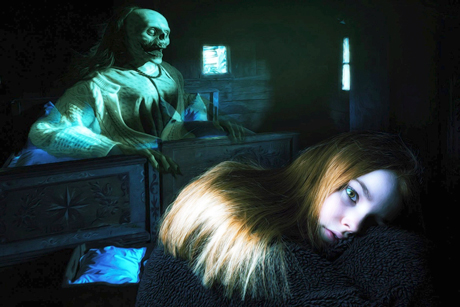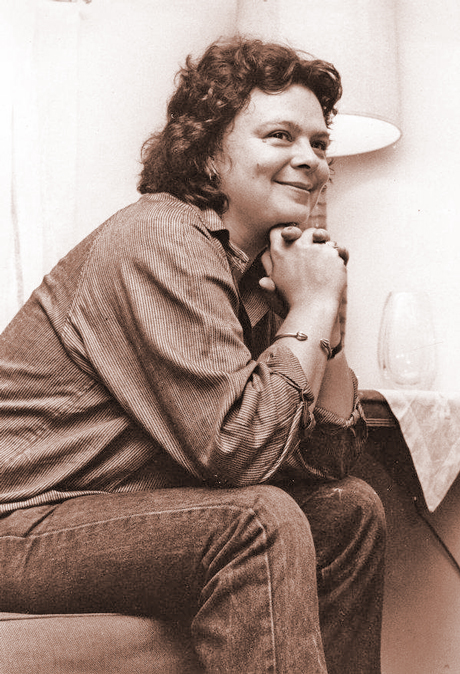May 1, 2019 issue
Authors' & Writers' Corner

Kamil Ali
The first visit occurred one night while I slept. I froze when I sensed its presence at my bedhead. I opened my eyes but did not turn around. A green emanation in the room reflected the image behind me. A green monster in a nightgown held on to the bedhead. Its body swayed like a slow pendulum pivoted at the center of its chest. A moldy smell crawled into my nostrils and burned my sinuses. I held my breath to remain still and stifle a sneeze. A sudden
Sunlight streamed through my window and woke me up. I did not recall falling asleep which convinced me that I had experienced a surreal nightmare. Daylight made me brave. I rolled off the bed and examined the location where it stood. I stuck my index finger into a green powder that coated the floor. Doubt and confusion crept into my heart. If I had experienced a nightmare, where did the dust come from? When I smelled it, the pungent scent sent me into a fit of sneezing. I rushed to the bathroom and washed my nose before I showered.
I got dressed and left for school after I had breakfast with my parents. The powder left a heaviness in my head that felt like a headache all day long. The incident plagued my every waking moment and distracted me. I learned nothing that day. That night I noted the experience in my diary and read a novel into the night with every light in my room turned on. Dawn’s early light would rescue me from another visit, whether in reality or in a nightmare.

I glanced at the coat of green dust the next morning without getting too close. Another day of yawning headaches from the lingering stench of the second dream churned my stomach and kept food and water from entering my mind and my mouth. My parents let me off of dinner when I told them that my stomach had not recovered from the pizza assault of the previous night. My diary captured the details of my second day’s experience.
Instead of reading a book in bed after homework on the third night, I sat at the small desk in my room and read it with the bright desk lamp on. I stretched after each chapter to keep myself from falling asleep. I ran downstairs a few times to fill my glass with chilled water from the fridge, which I sloshed down in gulps to shock my brain awake.
The green light entered my eyes and disappeared. I awoke with my hands on the open book and my head resting on them. When I entered the bathroom to brush my teeth, my brown eyes glowed green in the mirror. I blinked a few times to correct the color, without success.
Afraid of my parent's curious stares, I donned a pair of sunglasses for breakfast and made the excuse of red eyes from late night studying. Parental concern defeated my attempt at deception. My mom lifted the dark-tinted glasses off my nose-bridge and chuckled. My dad grinned. My mom flipped open her compact powder case and gave it to me to observe my eyes in the mirror under the cover. My eyes looked normal. I smiled for the first time in two days. My dreams had played with my mind and stoked my active child’s imagination.
Relief from the discovery lightened my heart and allowed me to focus on the day’s activities. A happy note in my diary ended the day and sent me into an early sleep of exhaustion after homework.
The first vision revealed a military plane that carried thirty-thousand pounds of nuclear warheads hurtling toward the ground. It crashed with an ear-shattering impact that rocked the Earth.
My blood ran cold the next morning when every news channel aired the breaking news of the plane crash. I suppressed the urge to disclose the details of my dreams to my parents to keep curious stares away from myself.
That night in my dream, I walked the Earth as the only living person left alive when a nuclear war devastated the planet after it annihilated every living organism. The sadness in my heart made me sit on a rock and wail for humanity. My green tears fell on the ground and scorched it. Wisps of smoke rose from the chemical reaction between the water droplets from my eyes and the barren earth. The mixtures churned and heaved with life.
I awoke the next morning and hurried downstairs. My parents gazed at the TV with pale faces. The network showed the onset of nuclear warfare. Unmanned cameras recorded the death and destruction that permeated the Earth. My dad flipped channels to track the direction of the damage. It headed our way.
I dashed upstairs to force myself to sleep. I had to find out how my dream ended. I came to the sad realization that my dreams had predicted the end of the world. The green nuclear chemical had disintegrated my body and left my consciousness trapped in limbo to relive the last days of an unending dream of the Armageddon with our bodies imprinted on our minds.

By Romeo Kaseram
Michelle Carla Cliff was born on November 2, 1946, in Kingston, Jamaica. Parents Carl Cliff and Lilla Brennan emigrated to New York following the child’s birth, leaving her behind with relatives, and returned when she was three years old. Writing in Contemporary African American Novelists: A Bio-Bibliographical Critical Sourcebook, Cora Agatucci tells us Cliff’s birth in its Jamaican locationality put her in a space that was “[at] once privileged and oppressed”. As Agatucci notes, “Cliff was born light-skinned (‘red people’ by Jamaican color hierarchies)”, her father a descendant of slave owners and a mother of African-Arawak-Carib ancestry. The entire family left for New York when she was three, and although “light-skinned”, as Agatucci notes, they were unable to “pass for white”, and were “never truly assimilated in the United States”.
Agatucci tells us the family returned to Jamaica in 1956, “where Cliff received a colonialist education at St Andrews private girls’ school”. Four years later, the family returned to New York, where during her college years, Cliff became a civil rights activist, and was drawn into the women’s movement. In 1969, Cliff earned her undergraduate AB degree in European history from Wagner College. In 1971, she worked at the New York publishing house, W.W. Norton. However, leaving New York behind in 1971, Cliff headed to the University of London, where she focused on languages and comparative history of the Italian Renaissance at the Warburg Institute, and convocated with a Master of Philosophy degree in 1974.
As Agatucci tells us, Cliff returned to W.W. Norton in 1974, where she worked until 1979 as a copy editor, and as a manuscript and production editor specialising in history, women’s studies, and politics. In 1975, Cliff met the poet, Adrienne Rich, and the couple became lifelong partners until Rich’s passing in 2012.
Agatucci notes that Cliff’s life and work resist “categorisation – by nation, race, gender, class, or genre”; that she is positioned at the “crossroads”, adding, “Growing up Jamaican meant growing up colonised in a ‘wild’, yet damagingly repressed, location, full of lost personal and collective histories, enforced silences, and deliberate erasures”. It is out of this location where the major themes of Cliff’s poetry and fiction emerge. As Agatucci further indicates, “At once privileged and oppressed, Cliff was born light-skinned…; resisted indoctrination as a ‘collaborator’ by a father descended of slave owners and a colonialist education; sought to recover her alienated African-Arawak-Carib maternal ancestry; and struggled to assert her lesbianism and writing aspirations.”
Meryl F. Schwartz, writing in Contemporary Literature, further explores the emergences driving Cliff’s writerly motivators, noting its focus on “creating a body of resistance literature that describes and formally enacts the struggle for cultural decolonisation”. She tells us, “…[Cliff] has written repeatedly of her struggle to claim her own voice, noting that ‘part of my purpose as a writer of Afro-Caribbean – Indian, African, European – experience and heritage and Western experience and education has been to reject speechlessness, a process which has taken years, and to invent my own peculiar speech, with which to describe my own peculiar self, to draw together everything I am and have been’.”
Further to this, Schwartz tells us Cliff, following her M. Phil. dissertation on the Italian Renaissance, “began a sustained examination of the Anglocentric education she had received”. Along with this, and partly as a consequence of her involvement in the women’s movement, Schwartz notes Cliff started “trying to use language to represent herself, and she discovered that in internalising colonialist ideology, she had lost access to crucial parts of her identity”. Thus, Cliff’s career as a writer, as Schwartz maintains, “began as a process of trying to reclaim the self through memory, dreams, and history”.
Writing in The New York Times, William Grimes notes Cliff’s “entire creative life was a quest to give voice to suppressed histories, starting with her own”. The essay, ‘Notes on Speechlessness,’ written for a women’s writing group in 1978, Grimes tells us, “can be read as the keynote for her subsequent work, which navigated the complexities of her life situation – she was a light-skinned black lesbian raised partly in Jamaica and partly in New York, and educated in Britain – against the broader background of the Caribbean experience”. As Cliff herself notes in a 1991 essay, ‘Caliban’s Daughter’, and quoted by Grimes, her intent was “to reject speechlessness, a process which has taken years, and to invent my own peculiar speech with which to describe my own peculiar self, to draw together everything I am and have been”.
Thus Cliff’s first book, Claiming an Identity They Taught Me to Despise (1980) addresses, as Grimes notes, “the problems of identity, history and colonialism in a series of prose poems”. Similarly, her The Land of Look Behind: Prose and Poetry (1985) pursues many of these themes. Cliff’s first novel, Abeng (1984), introduced the protagonist, Clare Savage, a light-skinned 12-year-old Jamaican girl who befriends the dark-skinned Zoe. Grimes tells us the novel traces “an idyllic relationship that cannot survive the harsh realities of race and class”. He later quotes Cliff speaking to Contemporary Authors in 1986, where she says, “Emotionally, [Abeng] is an autobiography… I was a girl similar to Clare and have spent most of my life and most of my work exploring my identity as a light-skinned Jamaican, the privilege and the damage that come from that identity.” In her No Telephone to Heaven (1987), protagonist Clare returns to Jamaica as an adult, where the reader is presented through a series of flashbacks of her life in New York and London, and the struggles for her to come to terms with her identity. Among her later books are Free Enterprise: A Novel of Mary Ellen Pleasant (1993), The Store of a Million Items (1998), an essay collection, If I Could Write This in Fire (2008), and her last novel, Into the Interior (2010).
Cliff’s teaching portfolio include Hampshire College and the University of Massachusetts at Amherst, Norwich University Vermont campus, Vista College in Berkeley, and the University of California at Santa Cruz and San Jose State; she was a visiting lecturer at Stanford University from 1987-1991, and was an Allan K. Smith Professor of English Language and Literature at Trinity College, Connecticut.
Cliff died from liver failure on June 12, 2016.
Sources for this exploration: Contemporary African American Novelists: A Bio-Bibliographical Critical Sourcebook; Contemporary Literature, Vol. 34, No. 4 (Winter, 1993); The New York Times, andWikipedia.